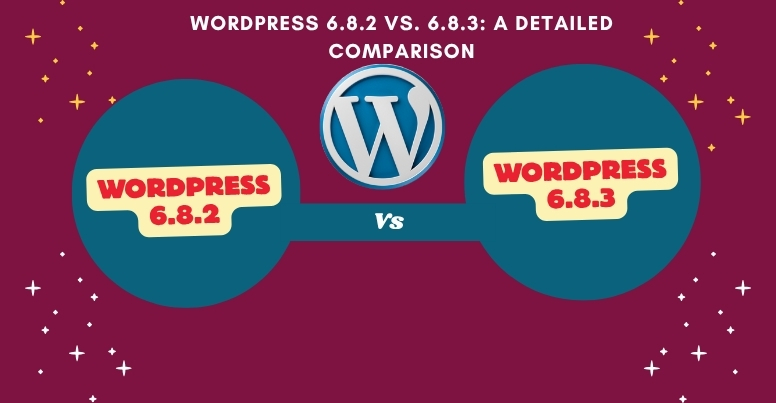WordPress 6.8.2 vs. 6.8.3: A Detailed Comparison
Significant baseline (6.8) features
Before diving into the maintenance/security versions, the foundational version is WordPress 6.8, released in April 2025, which introduced significant enhancements (Style Book, speculative loading, bcrypt password hashing, editing, and block improvements). WordPress.com+4Kinsta®+4WordPress.com+4. Both 6.8.2 and 6.8.3 build on that base.
Maintenance vs security release philosophy
Minor (maintenance) releases, such as 6.8.2, handle cumulative bug fixes, edge cases, regressions, and stability improvements. In contrast, security releases (such as 6.8.3) are targeted; they are issued promptly when vulnerabilities are discovered and typically carry minimal changes beyond patching those vulnerabilities.
Risk assessment for upgrades
Because 6.8.2 is a maintenance release, it generally carries a low upgrade risk; however, testing on staging is always prudent. The urgency is moderate. For 6.8.3, the urgency is higher: even though it is small in scope, the security risk means delaying the upgrade is riskier than any potential regressions.
Granularity of fixes
The fact that 6.8.2 has ~35 fixes (across core + block editor) suggests it addresses many more minor annoyances and corner cases. By contrast, 6.8.3’s minimal patch set implies that the fixes were narrowly scoped and likely identified after the 6.8.2 release.
Best practices when updating
Always back up your site (including files and database) before updating.
Test the update in a staging or development environment to check for compatibility with themes/plugins.
Monitor error logs or plugin behaviors after updating.
For security releases, update promptly, but still validate that nothing broke.
Summary recommendation
If you’re on version 6.8.x but not yet on 6.8.2, upgrading to 6.8.2 is recommended to gain the stability and bug fixes. If you are already at 6.8.2 (or later), then 6.8.3 should be applied immediately, as it addresses security vulnerabilities. The incremental risk of applying 6.8.3 is very low compared to the risk of leaving a security hole exposed.
| Category | WordPress 6.8.2 | WordPress 6.8.3 |
|---|---|---|
| Nature of changes | Maintenance / bug fixes (non-security) | Security patches (plus possibly minimal bug fix collateral) |
| Number of fixes | ~35 fixes (20 core + 15 block editor) (WordPress.org) | 2 security fixes (no large list of general bug fixes) (WordPress.org) |
| Scope / surface area | Broad: editor, styling, query blocks, UI behavior, etc. | Narrow: content access leak + XSS |
| Exposure / risk before patch | Many minor bugs, but no known high-impact core vulnerabilities (except external ones like CVE-2025-54352) | Risk that existed in 6.8.2 and earlier, now fixed (i.e. data exposure and menu XSS) |
| CVE / vulnerability identifiers | CVE-2025-54352 is documented affecting 6.8.2 (XML-RPC title guessing) (NVD) | The two fixes correspond to vulnerabilities (content access + XSS) but blog announcement does not list specific CVE numbers. (WordPress.org) |
| Urgency | Medium (recommended for stability) | High (security release, patch quickly) |
| Backward compatibility / risk of regressions | Low to moderate; should be safe but testing is prudent | Very low additional risk (small patch set), but still advisable to test |
| Target audience / impact | All users wanting stable site behavior, editors, block users | Sites with multiple user roles, membership / restricted content, navigation menus, security-sensitive operations |
| What you gain by upgrading from 6.8.2 → 6.8.3 | No additional bug fixes beyond 6.8.2 | Protection against known content-leak and XSS vulnerabilities; patching gaps in 6.8.2’s security posture |
From the official release announcement:
- The release addresses two security issues. WordPress.org+1
- The two vulnerabilities are: Vulnerability Description / Vector: Data exposure / Restricted content access. An issue where authenticated users (i.e., users with some level of login) could access content that should have been restricted. WordPress.orgXSS (Cross-Site Scripting) in nav menus. A Cross-Site Scripting vulnerability affecting navigation menus, requiring an authenticated user role. WordPress.org
- The documentation page confirms “2 security fixes” in 6.8.3. WordPress.org
- The release blog notes the responsible reporters (Mike Nelson, Abu Hurayra, Timothy Jacobs, Peter Wilson for the data access issue; Phill Savage for the nav menu XSS) WordPress.org
CVE / identifiers
- The public announcement does not list explicit CVE identifiers in the blog post. WordPress.org
- However, one relevant CVE is CVE-2025-54352, which affects versions up to 6.8.2: it allows remote attackers to “guess titles of private and draft posts via pingback. ping XML-RPC requests.” NVD
- Note: It is not entirely clear if this specific CVE is one of the two fixed in 6.8.3, but it’s documented to affect 6.8.2 and earlier. NVD
Thus, at least one disclosed vulnerability (private/draft post title exposure via XML-RPC) is linked to 6.8.2, and 6.8.3 presumably patches that (or related behavior).
In summary, 6.8.3 is an explicitly security release addressing a content access leak and a navigation menu XSS vulnerability, both of which are of moderate to severe severity, particularly on sites with multiple user roles or restricted content.

